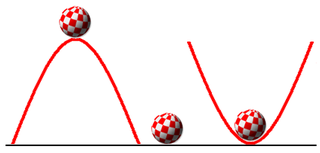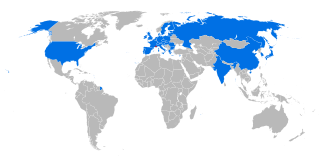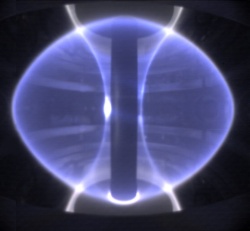
A tokamak is a device which uses a powerful magnetic field to confine a hot plasma in the shape of a torus. The tokamak is one of several types of magnetic confinement devices being developed to produce controlled thermonuclear fusion power. As of 2016, it is the leading candidate for a practical fusion reactor.

The stability of a plasma is an important consideration in the study of plasma physics. When a system containing a plasma is at equilibrium, it is possible for certain parts of the plasma to be disturbed by small perturbative forces acting on it. The stability of the system determines if the perturbations will grow, oscillate, or be damped out.

Fusion power is a theoretical form of power generation in which energy will be generated by using nuclear fusion reactions to produce heat for electricity generation. In a fusion process, two lighter atomic nuclei combine to form a heavier nucleus, and at the same time, they release energy. This is the same process that powers stars like our Sun. Devices designed to harness this energy are known as fusion reactors.

JET, the Joint European Torus, is the world's largest operational magnetically confined plasma physics experiment, located at Culham Centre for Fusion Energy in Oxfordshire, UK. Based on a tokamak design, the fusion research facility is a joint European project with a main purpose of opening the way to future nuclear fusion grid energy.

ITER is an international nuclear fusion research and engineering megaproject, which will be the world's largest magnetic confinement plasma physics experiment. It is an experimental tokamak nuclear fusion reactor that is being built next to the Cadarache facility in Saint-Paul-lès-Durance, in Provence, southern France.
JT-60 is large research tokamak, the flagship of Japan's magnetic fusion program, previously run by the Japan Atomic Energy Research Institute (JAERI) and currently run by the Japan Atomic Energy Agency's (JAEA) Naka Fusion Institute in Ibaraki Prefecture. It is properly an advanced tokamak, including a D-shaped plasma cross-section and active feedback control.

Magnetic confinement fusion is an approach to generate thermonuclear fusion power that uses magnetic fields to confine the hot fusion fuel in the form of a plasma. Magnetic confinement is one of two major branches of fusion energy research, the other being inertial confinement fusion. The magnetic approach dates into the 1940s and has seen the majority of development since then. It is usually considered more promising for practical power production.
DEMO is a proposed nuclear fusion power station that is intended to build upon the ITER experimental nuclear fusion reactor. The objectives of DEMO are usually understood to lie somewhere between those of ITER and a "first of a kind" commercial station, sometimes referred to as PROTO.

Alcator C-Mod was a tokamak that operated between 1991 and 2016 at the Massachusetts Institute of Technology (MIT) Plasma Science and Fusion Center (PSFC). Notable for its high toroidal magnetic field, Alcator C-Mod holds the world record for volume averaged plasma pressure in a magnetically confined fusion device. Until its shutdown in 2016, it was one of the major fusion research facilities in the United States.

The Experimental Advanced Superconducting Tokamak (EAST), internal designation HT-7U, is an experimental superconducting tokamak magnetic fusion energy reactor in Hefei, China. The Hefei-based Institute of Plasma Physics is conducting the experiment for the Chinese Academy of Sciences. It has operated since 2006. It was later put under control of Hefei Institutes of Physical Science.

The National Spherical Torus Experiment (NSTX) is a magnetic fusion device based on the spherical tokamak concept. It was constructed by the Princeton Plasma Physics Laboratory (PPPL) in collaboration with the Oak Ridge National Laboratory, Columbia University, and the University of Washington at Seattle.
The Plasma Science and Fusion Center (PSFC) at the Massachusetts Institute of Technology (MIT) is known internationally as a leading university research center for the study of plasma and fusion science and technology.

The KSTAR is a magnetic fusion device at the National Fusion Research Institute in Daejeon, South Korea. It is intended to study aspects of magnetic fusion energy which will be pertinent to the ITER fusion project as part of that country's contribution to the ITER effort. The project was approved in 1995 but construction was delayed by the East Asian financial crisis which weakened the South Korean economy considerably; however the construction phase of the project was completed on September 14, 2007. The first plasma was achieved in June 2008.
The beta of a plasma, symbolized by β, is the ratio of the plasma pressure to the magnetic pressure. The term is commonly used in studies of the Sun and Earth's magnetic field, and in the field of fusion power designs.

A spherical tokamak is a type of fusion power device based on the tokamak principle. It is notable for its very narrow profile, or aspect ratio. A traditional tokamak has a toroidal confinement area that gives it an overall shape similar to a donut, complete with a large hole in the middle. The spherical tokamak reduces the size of the hole as much as possible, resulting in a plasma shape that is almost spherical, often compared with a cored apple. The spherical tokamak is sometimes referred to as a spherical torus and often shortened to ST.

The Culham Centre for Fusion Energy (CCFE) is the UK's national laboratory for fusion research. It is located at the Culham Science Centre, near Culham, Oxfordshire, and is the site of the Joint European Torus (JET), Mega Ampere Spherical Tokamak (MAST) and the now closed Small Tight Aspect Ratio Tokamak (START).
The GLAss Spherical Tokamak is a name given to a set of small spherical tokamaks located in Islamabad, Pakistan. They were developed by the Pakistan Atomic Energy Commission (PAEC) as part of the National Tokamak Fusion Program (NTFP) in 2008 and are primarily used for teaching and training purposes.

Tokamak COMPASS is the main experimental facility of Tokamak department of Institute of Plasma Physics of the Academy of Sciences of the Czech Republic since 2006. It was designed in the 1980s in the British Culham Science Centre as a flexible research facility dedicated mostly to plasma physics studies in circular and D shaped plasmas.
Ksenia Aleksandrovna Razumova is a Russian physicist. She graduated from the Physical Faculty of Moscow University in 1955 and took a position at the then called Kurchatov Institute of Atomic Energy in Moscow, then USSR. She defended her Ph.D. in 1966, was Candidate in Physical and Mathematical sciences in 1967, and became Doctor of Sciences in 1984. She is laboratory head at the Institute of Nuclear Fusion, Russian Research Centre Kurchatov Institute. Since the beginning she is actively involved plasma physics in research on the tokamak line of Magnetic confinement fusion..